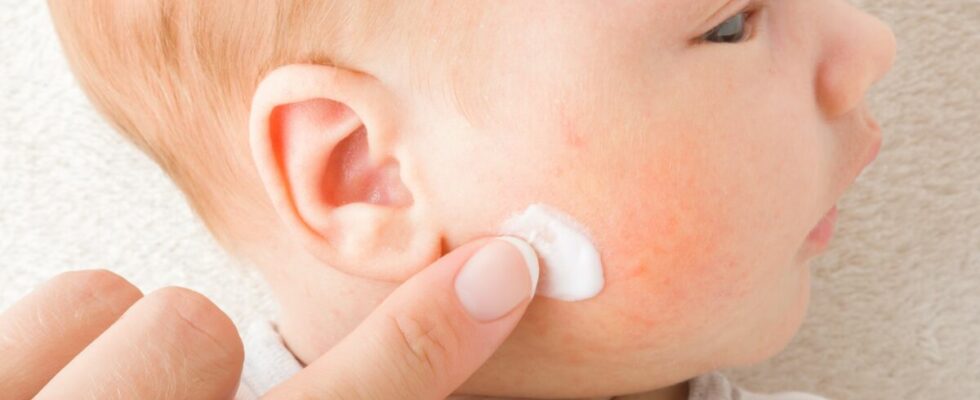Infant acne generally appears between the ages of 1 and 5 months. Unlike juvenile acne which is itchy and sometimes leaves scars, neonatal acne does not cause itching and disappears spontaneously within a few weeks. Find out what baby acne is, what its causes are, its treatments and how long it lasts.
1. Causes of baby acne
The causes of infant acne divide specialists. For the majority of them, it is a hormonal factor that is involved, specifies the university thesis in pediatric dermatology entitled “Recognition and care in the pharmacy” of pharmacy doctor Renaud Guidetti. Indeed, at the end of her pregnancy, the mother-to-be experiences a hormonal surge. However, the baby shares hormones with her, via the placenta. This increase in the level of hormones in the blood would cause excessive secretion of sebum by the sebaceous glands in infants, which would lead to the appearance of acne renamed hormonal acne. For other specialists, the medications taken by the mother during pregnancy, her specific diet, her stress, the existence of a family history of acne, would influence the appearance of acne in the infant.
2. Symptoms of Neonatal Acne
Neonatal acne is a dermatosis whose symptoms should not be confused with atopic eczema, heat rash or toxic erythema in particular. If a few weeks after birth, your baby’s skin becomes covered in pimples, here are some things to know to know if it is infant acne:
- Their appearance: infant acne appears in the form of small red spots (papules due to inflammation) or white spots (closed comedones). In some cases, purulent skin lesions (pustules) may also be observed.
- Their location: neonatal acne is mainly seen on the baby’s forehead, cheeks and sides of the nose. However, acne can also spread to the chest, back and scalp. Although this rash is impressive, it remains benign.
- The absence of itching: unlike certain dermatoses, infant acne does not cause itching or discomfort in your baby. These buttons are just unsightly.
3. Treatment and duration of baby acne
Infant acne does not require medical treatment and resolves spontaneously within a few weeks in the vast majority of cases. In fact, it takes between 1 and 3 weeks on average for your baby’s acne to disappear, without leaving scars on their skin. Furthermore, the fact that your baby suffers from neonatal acne does not mean that he or she is predisposed to later developing juvenile acne.
On the other hand, it is necessary that you adopt the right actions so as not to risk superinfection of the spots or causing marks on the skin. You are therefore advised not to try to puncture blackheads, nor to use products against infantile or juvenile acne, as they are not suitable for the fragility of your infant’s skin. Also avoid cleansing products or greasy creams on your infant’s skin, as they contain comedogenic elements. Consequently, the right actions to adopt are to clean your baby’s skin with water alone, once a day. You can also opt for misting water or physiological serum. Once baby’s skin has been cleaned, remember to dry it well, as well as every time he drools or regurgitates. Humidity is in fact an aggravating factor in acne. Finally, take care to cut your baby’s nails regularly, so that he does not use them to scratch his acne spots.
4. Complications of infant acne
It may happen that your baby’s acne lasts beyond 3 months and becomes infected. In this case, the acne progresses from neonatal acne to infantile acne and can leave scars on the skin. This is why it is important to consult your pediatrician if you are in this situation. If the acne is considered severe, the doctor may prescribe local antibiotic treatment, such as retinoid, benzoyl peroxide, or even erythromycin. If this drug treatment does not give sufficient results, then oral antibiotic treatment can be considered, such as isotretinoin. It should be noted that antibiotics used against juvenile acne, such as cyclins, whose results are very satisfactory, cannot be prescribed to infants. Childhood acne is therefore more difficult to combat.
Sources
- Infant acne: causes, symptoms and treatments, Hospital information, December 7, 2021
- Rashes in Children, The MSD Manual — Consumer Version, November 2022
- Seborrheic Dermatitis, The MSD Manual — Healthcare Professional Version, January 2023
- Acne in newborns and infants, Annals of dermatology and venerology, May 23, 2008
- Pediatric dermatology: recognition and care in the pharmacy, thesis of Dr Renaud Guidetti, doctor of pharmacy, 2017
Read also :
⋙ Acne: 10 effective tips to get rid of it
⋙ Hormonal acne in adults: what are the most effective treatments?
⋙ Acne, shingles and psoriasis: a dermatologist answers all our questions
